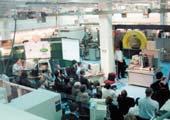| |
The Myth of Manufacturing's Demise
Here at the close of the twentieth century, manufacturing accounts for one-fifth of the nation's gross domestic product and employs 17 percent of the U.S. workforce, according to the National Science and Technology Council. More significantly to the nation's economic well-being throughout the 1990s, productivity in manufacturing—the ability to produce more goods using less labor—far outstripped productivity in all other sectors of society, including the service sector. As the nation's productivity leader, manufacturing has helped the nation to achieve low unemployment with only modest inflation.
This record of success seems remarkable when compared to the state of manufacturing just twenty-five years ago.

By the mid-1980s, the U.S. was no longer "the unquestioned technological hub of the world," according to Harvard physicist and Nobel Laureate Sheldon Glashow, but was instead passing "the torch of scientific endeavor" to other nations. "Steel, ships, sewing machines, stereos, and shoes" were "lost industries," he said. Unless something was done soon, Glashow exclaimed, Americans would be left with "their Big Macs… and perhaps, [their] federally subsidized weapons industries."
Says Louis Martin-Vega, NSF's acting assistant director for Engineering and former director of the directorate's Division of Design, Manufacture, and Industrial Innovation (DMII), of that troubling time, "There was a realization that, well, we've lost the electronics business, the automotive industry was hurting, the machine-tool industry was all Germany and Japan, and then it seemed like we were going to have the same fate in the semiconductor industry."
The potential loss of an industry so crucial in the burgeoning Computer Age frightened public officials and turned federal attention to manufacturing-related research in a new way. In 1987, the government worked with industry to start a research consortium of semiconductor companies known as SEMATECH. The group continues to operate today, (having weaned itself from government support) with member companies sharing expenses and risk in key areas of semiconductor technology research.
Within NSF, says Martin-Vega, "The argument for supporting work in manufacturing was made less difficult when you had a situation that could almost be considered a national threat." Engineering research seeds planted in the early 1970s began to bear fruit. By the mid-1980s, some pivotal scientific foundations for design and manufacturing were in place. To build on them, in 1985 NSF established a separate design and manufacturing division.

NSF helped to move manufacturing from the obituaries to the headlines, which now are more likely to celebrate the "new manufacturing," with its reliance on information technologies and more malleable, quick-response organizational structures. As the following highlights demonstrate, with some critical assistance from NSF, U.S. manufacturing isn't dying after all—it's just changing.
|
|
